COCKNEY LIZ |
|
She was born in 1863 in Woolwich a market town in the county of Kent Middelsex, England as Elizabeth Martha Burgess known as Liz to her friends and family. She had three brothers, Anthony, Joshua and Ronald and a sister named Mary. The above book details her family background and her engagement to Roy Spencer, born 1858. , which ultimately led to Liz coming out to South Africa. The fabricated facts of who Roy Spencer really was is set out in this book.
Cockney Liz arrived in Barberton by mail-coach in January 1886, in an attempt to try and find her fiance.
Only much later did she find out that he
had been shot for stealing his partner's savings. This in fact was untrue as he had been accused of theft by his friend Walter Scott, with whom he had journeyed out from England. Walter whilst under the influence of drink at Pilgrims Rest, accused Roy of stealing his gold and this resulted in Roy being shot by him.
When Walter returned to his tent, he was horrified to find his gold in a purse that had fallen from his pocket. In an attempt to seek forgiveness he ran to the Methodist Church in Pilgrims Rest and finally shot himself. You can read the details in Hans Bornman's book how Roy was buried in "Robbers Grave in the Pilgrims Rest cemetery and Walter was buried alongside him in an unmarked grave. |
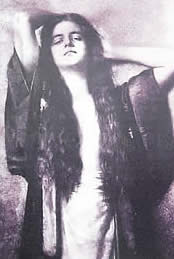
|
Stafford Parker, with whom she had traveled down to Barberton on the coach, introduced Liz to
Mrs. Emily Fernandez owner of "The Red Light Canteen" where she started working as a barmaid and eventually one evening while Emily was playing the piano Liz joined her in singing, which led to her being asked to sing many encores.
Her very first performance was a great success which we are told, "Brought the house down" and after that Liz was one of the star attractions in town.
Even though she had no professional training Liz gave a lot of people pleasure with her singing and her
dancing.
She certainly must have had a
vivacious personality, combined with the ability of knowing how to handle men.
She eventually rose from being an entertainer to being the owner of not only the Red Light Canteen but also of the Royal Albert Hall, with its fake ceiling of the night sky with stars and all.
She achieved fame by putting herself up for auction on some evenings to the highest bidder.
One successful bidder bid 96 Kimberley Imperial Gold Mining Company shares valued at £805. He over-celebrated his good fortune and passed out alone on the bar floor. He did not get his shares back.
|
STAFFORD PARKER
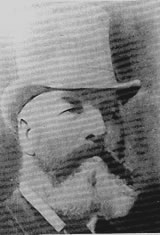
|
Cockney Liz was a remarkable woman and the talk of the town, her hairstyles and mannerisms and songs were copied by many young teenage girls, much to the consternation of their mothers,
who thought her a "Brazen Hussy".
In truth Cockney Liz must have had a major effect on Barberton’s social life and
morals, for the two years that she was there.
The saucy look that she was famous for, (just look at the photo), must have caused many of those strong men to yearn to be the man in her life.
It is told that Stafford Parker, was her friend and confidant and nothing more.
For a long time Liz's true story was unknown, so we did not know for sure if she sank into the gutter or rose to be a lady and wife of some aristocrat.
Liz left town and disappeared. Stories went around that she went to the Witwatersrand, where she died in poverty. No one knew the true story and so she remained a legend and an unsolved mystery.
According to a 1888 issue of the Goldfields Times, in the Barberton museum, Cockney Liz married an Alfred Percival Scribbens.
There is a romantic side of me that wanted to think that she did not just fade away into quiet obscurity.
Han Bornman's book has now revealed the true and sordid facts of her life, which for me has destroyed the romance of the legend.
Now thanks to Hans Bornman and his research, he tells in his latest book that Percival Scribbens, who was also on the coach with Stafford Parker when Liz traveled to Barberton,at a later time contracted Black water fever in Delagoa Bay. This is a very severe form of malaria with a high mortality rate and Percival Scribbens arrived in Barberton comatose and at deaths door. He was nursed back to health by Liz and upon his recovery recognised Liz from the coach journey down to Barberton from Kimberley. He eventualy proposed to her in a most romantic fashion. Liz accepted and before leaving Barberton she destroyed all the photos of her and removed as much trace of Cockney Liz as she could.The above photo was a pin up photo in the Masonic Hall taken in 1886 and was overlooked by Cockney Liz. This correct photo was only recently re-discovered and features on the cover of Hans Bornman's book
She left Barberton in mid December 1887 on the coach with the same driver, Charlie Griffith's, who had driven her down to Barberton in January 1886. On her journey back to Johannesburg she went via Pilgrims Rest and visited Roy's grave as Robbers Grave in the Pilgrims Rest cemetery to say her last "Goodbye" to him and the life that she had been forced into.
When Liz arrived in Johannesburg she went to visit Alfred Beit, who was one of the Mining Magnates and Rand Lords of early Johannesburg and who had proposed marriage to her, to tell him of her decision to marry Percival Scribbens. He mentioned that he understood but that if she wouldn't marry him he would remain a bachelor for the rest of his life, which he in fact did. Carl von Brandis the Chief Magistrate of Johannesburg and who was later on to become the Mining Commissioner of the Witwatersrand Gold fields married Liz and Percival Scribbens on the 17th January 1888.
Liz could not shake off the tainting of her past and trouble was brewing in the person of one Alfred Percival who had heard of Liz's lifestyle in Barberton and knew that her husband knew nothing of it. Before the wedding he confronted Cockney Liz and demanded money for his silence because he knew Liz to be a wealthy woman. Liz had no choice and had to organise the money which delayed the wedding and caused her much anxiety. After the wedding Percival again demanded not only money this time but sexual favours as well. This escalated into sexual favours for his friend, one Charles Derisley, as well as more money. Eventually Liz had no more money and she stopped all favours and payments.
Percival then told Alfred Scribbens about her adultery and shocked and betrayed he sued for divorce. Derisley testified at the divorce trial and Liz was officially divorced on 3rd November 1890. Liz had during the seperation moved to Durban and was a barmaid at the Royal Hotel.
Liz then moved to Cape Town and became a barmaid at the Mount Nelson Hotel where she was arrested for prostitution and sent to a House of Correction or womens' prison.
It was while in prison that she contracted an inflammation of the colon (Colitis gastritis) and succumbed to the infection on 30th June 1900 aged 37. She was buried in an unmarked pauper's grave in the Maitland cemetery in Cape Town.
Cockney Liz had always fascinated and intrigued many people that she had been in contact with and after leaving Barberton many stories surfaced about her having been seen on a London railway statiion and another story that she had become an estate agent and was married with two children. Sadly the legend has now become sordid reality.
|
THE GOLDEN DANE |
During the rough and ready early days of the gold rush there was a shortage of women who were prepared to live under those conditions.
So for "Ladies of the night" or "Soiled Doves" there was a thriving need for their business amongst the rough and tough diggers who came to seek their fortunes.
Girls, like The Golden Dane, Cockney Liz, Florrie and Trixie to name a few who were prepared
to sell their services to the local diggers, were in great demand.
Trixie was a very popular Barberton barmaid, because- it is told - she used to push
her customers home in a wheelbarrow if they became too inebriated.
One of the most attractive ladies in Barberton was a blonde bombshell of great beauty, known only as the "Golden Dane".
To all purposes she appeared to be the main rival of Cockney Liz.
Where she came from or who her real name was no one knew,
except that she regularly
mailed letters to Denmark in Europe, hence her nickname.
Many of the men and diggers tried to win the attention and hands of these girls in marriage.
Like Cockney Liz, The Golden Dane kept her options open and as broad as possible and would not be coerced
into any permanent relationship.
If they allowed this to happen it would have ruined their business.
There is an urban legend that at one stage, a Jewish man spread a rumour in town that he had won her hand and that he was engaged to her.
When she heard the story, The Golden Dane armed with a shambok, found him as he was drinking in one of the local saloons.
|
THE ROYAL ALBERT HALL 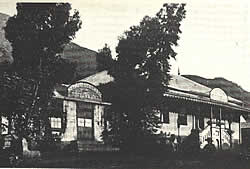
THE INTERIOR ROYAL ALBERT HALL
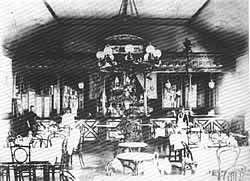
|
She confronted him and made him take back his words in front of all the witnesses in the bar.
She further informed him that for no amount of money would he ever
make use of her services again. The story goes that he meekly complied.
Although these girls were considered "Brazen Hussy's" by the local more staid ladies of the community, they did contribute a lot of their own time and money to help the miners and diggers as well as the community.
Nearly all of them did volunteer work at the local hospital, helping to keep their client base and others healthy.
During one bad time of malaria fever in the digging camps, the Golden Dane attended to the diggers in their tents. She tried to bring them comfort, as they
suffered and in some cases lay dying of the fever.
She never accepted any money and in fact used some of her own money to help the diggers during their battle with malaria.
She had not been seen or heard of for a few days,so some diggers went to find out what was wrong.
They found her in her room in a coma as she was suffering from malaria. The diggers then took turns at nursing her, but two days later, she died of malaria
When her belongings were checked, not a single clue as to her real identity or any next of kin was found.
The Golden Dane passed away into legend and history without anybody ever knowing who she really was.
|
FRENCH BOB AND TOM MCLACHLAN |
FRENCH BOB
The most resolute and persevering of prospectors in the Kaap Valley also known as "The Valley of Death", were three men, Ingram James, Magnus Jefferies and a Frenchman August Robert, known as "French Bob".
French Bob was born in France in 1848 and he became an engineer. He joined the Kimberly diamond rush without success. He then moved to Pilgrims Rest, also without any major success. He fought in the Sekhukhune war, fought for the British in the Zulu war and for the Transvaal at Majuba.
These three prospectors had arrived at Duiwels Kantoor now known as Kaapschehoop in 1882 and had wandered down into the Kaap valley.
People soon saw that they were having some success because they were able to pay for supplies in gold as well as banking the odd nugget or so.
The crowd of diggers at Kaapschehoop were in a frenzy of curiosity as to where these finds were made and many attempts were made to find out.
Tom McLachlan who is considered to be one of the greatest of South African prospectors went down in "Digger History" with the following tale. In September of 1882 he paid his last visit to Duiwels Kantoor. Mclachlan found that the diggers there would do anything for information of somebody else's discovery. They fed him copious amounts of strong drink to get him to divulge his activities, of which he refused to breath a word. He did however inform them that he knew where French Bob and his two companions were finding gold. After being fed much drink, he agreed to lead them there after he had tied up his business.Two hundred diggers packed their things waiting to be shown the way. Mclachlan finished earlier than they realised and left a note telling them to meet him at a certain spot on October 2nd. When they got there they found a note under a stone leading them to another spot, with another note and so on. This went on for days through really rugged country and the diggers gradually exhausted by now, returned to Duiwels Kantoor knowing that they had been duped.
|
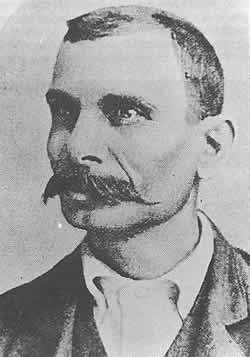
FRENCH BOB
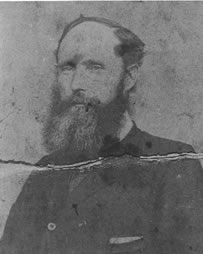
TOM MCLACHLAN |
Mclachlan despised what he called vultures waiting for other men to do the work and then descend on their findings, had led them a merry chase but he wisely never went back to Duiwels Kantoor.
The actual site of French Bob and his companions find was along the banks of the Ngwenyana stream known as the North Kaap. Ingram James had been responsible for the first discovery. They worked in secret but in early 1883 Henry Culverwall stumbled on their site and pegged out a claim. The news spread and within days there was a rush to what became known as Jamestown in honour of Ingram James. This rush was short lived and French Bob and his companions worked the length and breadth of the Kaap Valley and found many traces of gold, but a water shortage put them off working many of their finds, including what was to become the Sheba Reef. French Bob wandered along what became known as Queens River after the Swazi queen Yoyo of the Mjindini Kraal. He found traces of "Rotten Reef" that he described as the best find yet.
A man named Wylde tried to double cross everybody by getting a concession from the queen on what became known as Concession Creek.
French Bob called Mr Ziervogel the mining Commissioner to settle the dispute. Even though the findings were on Moodies grant nothing was settled. Most of the prospectors left in disgust. However on Sunday 3 June 1883 French Bob at the head of the Creek found what was then the greatest gold find in Southern Africa "The Pioneer Reef".
The three prospectors agreed to inform Moodie and started working on a six mile water race. Once they started work on the race all secrecy ended and a rush started. Very soon news had spread not only throughout Southern Africa but right around the world.
The greatest rush since the discovery of diamonds ensued and this was to establish the Transvaal Republic as the the greatest producer of gold in the world.
He was a prospector of courage , patience, resourceful and held in high esteem by his fellow diggers. |
|

